Among the famous small aquarium inhabitants, there are individuals larger, but no less beautiful. The blue dolphin is a large, spectacular and unusual fish. In our article, we will consider the basic rules for the care and maintenance of such a pet.
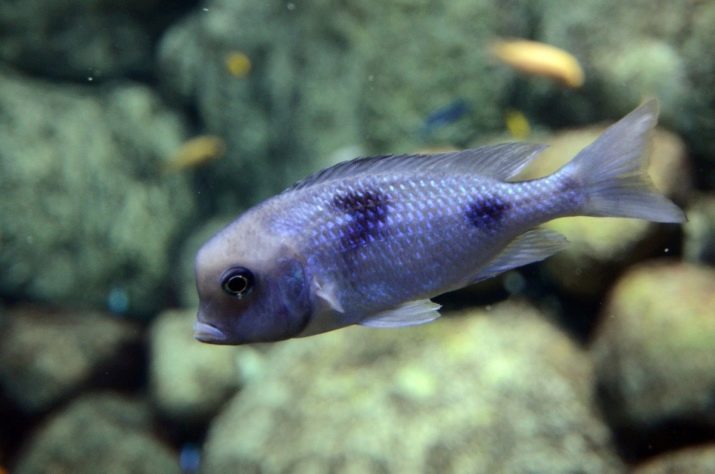
Description
The blue dolphin aquarium fish also has another name - zirthokara muri (Cyrtokara moorii). This handsome native of Africa, his habitat is Lake Malawi. In the wild, this fish reaches a size of 20–25 cm. Dolphins swim in a flock near the coast, at a depth of 10 m. In nature, the diet consists of insect larvae and worms.
They are assisted by larger cichlids in their diet, which dig the soil in search of food and raise a lot of tasty from it, while a flock of dolphins keeps nearby and picks it all up. Some researchers argue that zirthocara, if necessary, protects fish, helping it in finding food.
This species was first described in 1902 by George Boulanger. The name of the fish comes from fat deposition (cones) on the forehead of large males (“circus” means “round”, “cara” - “head”). The species itself was named in honor of George Moore, who found in several of his expeditions a large number of such cichlids. Subsequently, they were described by Boulanger. These individuals came to Europe in 1968. They were brought to the USSR in 1977 by S. M. Kochetov, who later engaged in the selection of these fish.

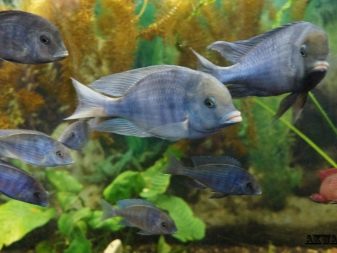
This fish is called a dolphin because of its resemblance to a real dolphin. The thing is the growth on the head, which becomes larger with age. Fish have big eyes and large lips.Young individuals carry transverse stripes and a pair of dark spots on their sides. Having matured, the fish acquires a light blue color, sometimes retaining spots. During mating games, the body of the main male of the group turns dark blue, the forehead turns yellow, and several transverse stripes appear on the sides.
The blue dolphin has a high body, slightly elongated in length and flattened on the sides. These fish have long dorsal and anal fins, as well as a two-lobed posterior. The ventral and pectoral fins are short and thin.
Male from female can be distinguished at the age of 12-18 months. Males are larger than females; on their head there is a large pineal growth. They are also slightly brighter than females. In the aquarium they grow up to 8-10 cm.
The size of the tank depends on the volume of the fish and the conditions of detention.
Life expectancy in the aquarium is up to 15 years.
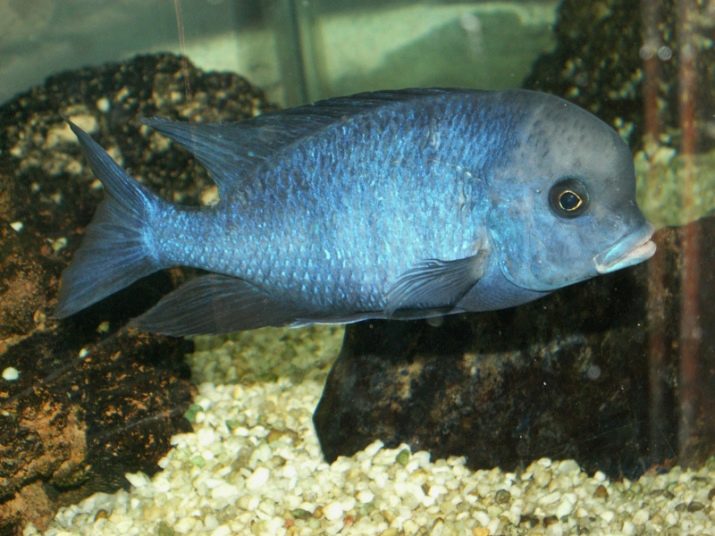
Behavior
The blue dolphin is a very smart and quick-witted fish that behaves without undue aggression. When moving slowly, these underwater pets are graceful and calm, and during the catch-up games they are very playful. It is interesting to observe the process when the male tries to impress the femalewhile he spreads his fins and demonstrates swimming skills. As for the offspring, these are wonderful parents who have no problems with raising young animals.
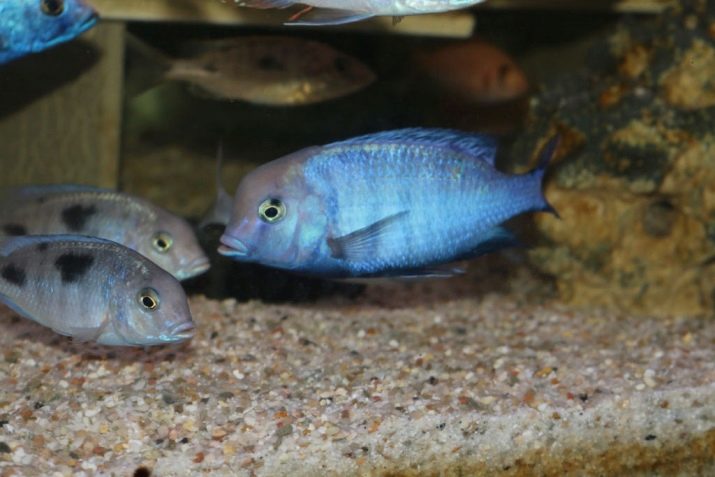
Content Features
Comfortable water temperature in the aquarium is from +24 to +28 degrees. The recommended volume is at least 200 liters. A weekly change of 30% water to fresh is needed. A biological filter is ideal for keeping this fish at home. In the absence of the latter, powerful filtering and air purging are suitable.
For this individual, a moderate course is required. You should take care of the availability of space for swimming, as well as grottoes, snags and plants. If blue dolphins live in the aquarium, the soil in it should be medium and large fractions, and plants should be planted only with strong roots. The described individuals occupy the middle and lower layers of water. Although the fish belongs to cichlids, in fact it has a very peaceful and calm character, and sometimes pets can be very shy. Given this, it is advisable to keep them in a species aquarium.
Males love to measure their strength, but it doesn’t reach serious injuries or victims. In order for a dolphin’s life to be calmer, 3-4 males or 2 males for 5-6 females should be in a tank for 1 male. A flock will choose its territory and will guard it. The dominant male will immediately stand out and begin to monitor the order in the pack.
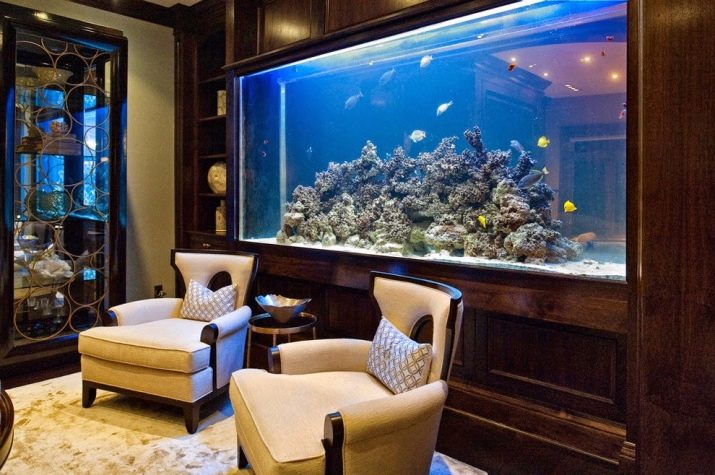
Zirtokaras can recognize their master as he approaches the aquarium.
You need to feed them 5 times a day with a pipe maker, bloodworm, small fish (not sick).
Excess feed must be removed from the aquarium. You can’t feed with any feed of animal origin, as this will lead to obesity, degeneration of internal organs and many other diseases.
Breeding
The very first experience in breeding blue dolphins in an aquarium occurred in 1979. Conducted by Dr. G. Schubert.
The main factor for successful spawning is the correct and abundant feeding of producers. No less than a week before spawning, parents need to be fed with high-quality and best of all live food. Sometimes blue dolphins can begin to spawn at the age of 8–10 months, which is not desirable, since it can lead to disruption of some cycles and weakening of an organism that has not yet fully formed. In the future, such a producer will have weak offspring.
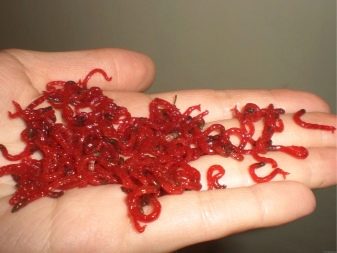
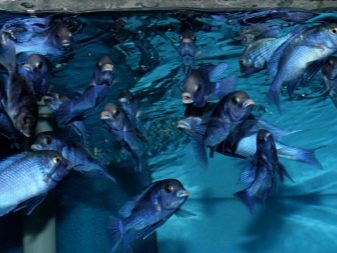
Stable spawning with good results can be obtained from fish no younger than 14 months old. Having reached this age, the fish can spawn every 2 months. This will continue until the individual is 8 years old.
Males ready for spawning can be identified by the yellowed growth on the head, which becomes larger with each spawning, and on the sides the transverse strips become more noticeable.In females, the color becomes lighter, a noticeable swelling appears near the anus.
Before spawning, males become more aggressive towards each other, which is accompanied by frequent fights in the upper layers of water.
The dominant male chooses the place where the caviar will be placed. To do this, he can dig a hole or choose a smooth stone. Next, he will begin to clean it. A hole can be dug either alone or together with a female. In the future, love games will begin, after which the female lays 5–7 eggs at a time, and the male fertilizes them. This procedure is repeated several times, with a small interval in time. All spawning lasts about 1 hour, after which the female collects all the caviar in her mouth and carries it there.

The eggs of the described fish are rather large - about 2.5 mm, oval, amber.
Caviar incubation takes place at a water temperature of +26 degrees and can last up to 25 days.
The female releases from the mouth the already relatively large (about 1 mm) gray fry. After hatching the babies, the female hides them in her mouth in case of danger or at night. After some time, the transparent-yellowish anal fin of the fry will become a reddish hue, and a pair of large, irregularly shaped spots will appear on the sides. Malkov remains about 40-60% of the total spawned eggs.
In the case when your fish spawned in a common aquarium, it will be very difficult to keep the offspring. Here, the female will be affected by some unfavorable factors - from food to neighbors in the aquarium, who will perceive the female fry emerging from the mouth of the female for food and will begin to hunt for them.
If spawning has taken place in a common aquarium, then a female with caviar in her mouth can be tried to be put into another tank, but she will have to act with extreme caution. The main problem is that the female blue dolphin, unlike other cichlids, which under no circumstances will independently give eggs, can spit it out at the slightest stress, and it will be eaten by other residents of this reservoir.
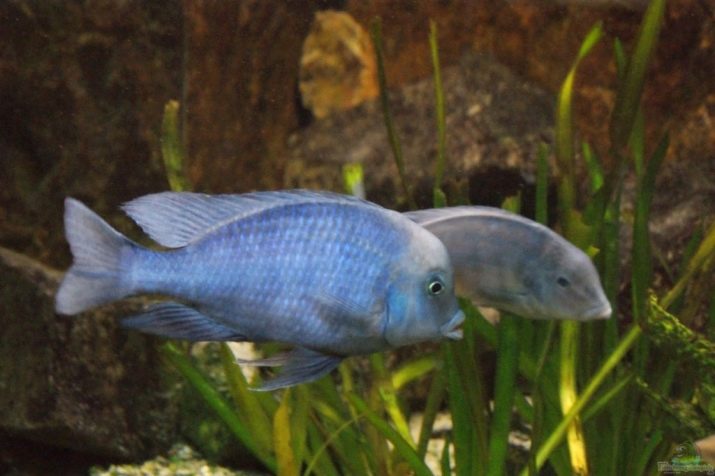
To avoid this, the process of "moving" is best to start at night, about 2-3 hours after turning off the lights. To do this, you need a net with a cell size smaller than the size of the eggs - this is due to the fact that during the transplant the female will still throw eggs, but she will remain in the net, and there is a chance that she will collect it in the future.
With proper and abundant feeding, fry are added 8–10 mm per month, and soon they will need to be removed to another aquarium. At first, young individuals have an ugly, grayish color. Only after reaching a size of 4 cm, the color begins to change to blue or pale blue. Dark spots may sometimes appear. From the age of 8 months, the fins in the juveniles begin to lengthen, and the forehead rounded.
Despite the fact that the fry of this species are quite large in size, for their "raising" you will need to fulfill certain conditions.
- The first condition is the presence in the aquarium with fry of powerful filtration, which does not create a strong current.
- The second and most important condition will be regular feeding. The fact is that fry of this species are not particularly voracious, but they need a lot of food for growth, so their diet should be moderately nutritious and properly balanced.
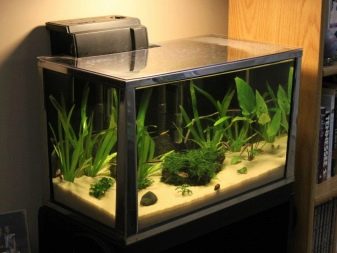
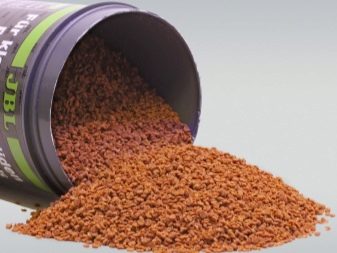
Due to improper feeding, the fry can die from inevitable dystrophy. Also, the cause of the mass death of babies can be a drop in temperature below +21 degrees.
Compatible with other fish
This fish is considered peaceful and does not show aggression towards its neighbors, with the exception of spawning time. It can coexist seamlessly with many species of fish that do not fit in her mouth.
If there is no possibility or desire to maintain a species aquarium, then as neighbors are suitable:
- non-aggressive cichlids;
- large barbs;
- catfish sticky;
- scalaria;
- blackheads.
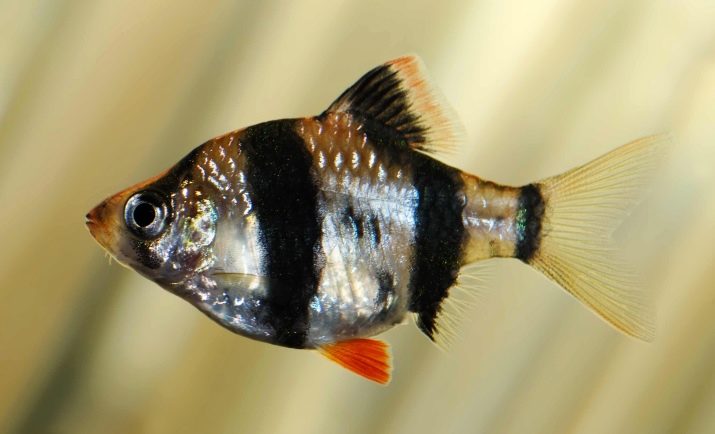
How to choose and plant in the aquarium?
It is better to make a purchase in a trusted store with a good reputation and conditions for keeping fish.
Before buying, carefully inspect the fish for damage to the scales or fins, spots on the body.
Any kind and color of specks, as well as plaque will talk about various diseases. It is better to refuse to buy such fish.
In the absence of the above defects, observe the behavior of the fish - it should not fall to one side. A healthy blue dolphin should swim confidently and smoothly.
After delivery to your home, do not rush to plant new pets in the aquarium, if they are not the only inhabitants in it. This is due to the fact that the fish can be outwardly healthy, but be a carrier of some diseases that other inhabitants of the reservoir will suffer from.
If you already have an expensive fish in your tank that you don’t want to lose or treat, then you should be safe and put the newly purchased individual in quarantine.
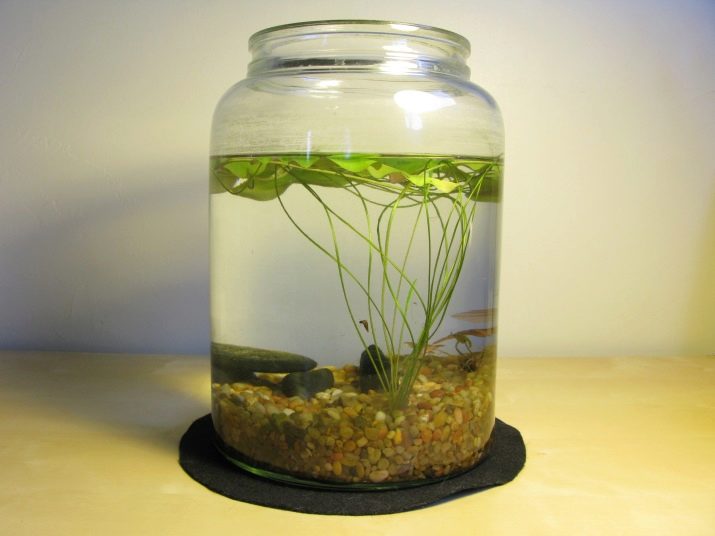
Quarantine is a regular aquarium located in the next room, always separated by a door. Fish diseases are transmitted from the aquarium to the aquarium by airborne droplets. In this regard, placing the quarantine near or in the same room with a common aquarium loses all meaning.
Keep a blue dolphin in isolation for at least 7 days. If a fish does not manifest any defects during this time, this does not mean that it is absolutely healthy. You can check this in a simple way: transplant one individual from the general aquarium into the quarantine and observe for 2-3 days. If during this time the fish did not die and did not get sick, then you can transplant into a common tank.
Such a procedure will give a complete picture of the safety of the acquired fish for the underwater pets already living with you. The economic benefit in this procedure is also present, since treating 2 fish is easier and cheaper than all that you have.


Disease
This chic cichlid has good immunity, but with improper care can get sick. Consider the most common diseases in this species.
- Hexamitosis. It is manifested by the expansion of pores on the head in the region of the lateral lines. In this disease, the fish do not eat anything and suffer from exhaustion. Cure the disease can only be metronidazole. The neglected stage is difficult to treat, and the fish is likely to die.
- Ichthyophthyroidism. Better known as "semolina." In the presence of this disease, a characteristic white coating appears on the body of the fish, which is treated only by specialized means.
- American bloating. This disease is manifested by inhibition of fish and loss of appetite. The body of the individual inflates, and the eyes come out. This disease kills fish in 3 days. Most often, a similar ailment appears in fish that originated from Lake Malawi. It is treated only with strong antibiotics.
- Saprolegniosis. During this disease, growths resembling cotton wool appear on the body of the pet. You can get rid of this disease only by means of which phenoxyethanol is a part.
Blue dolphin breeding and care tips can be found in the video below.










